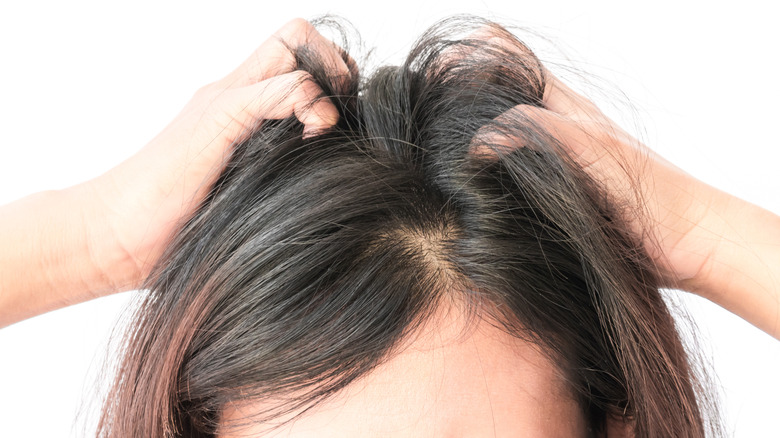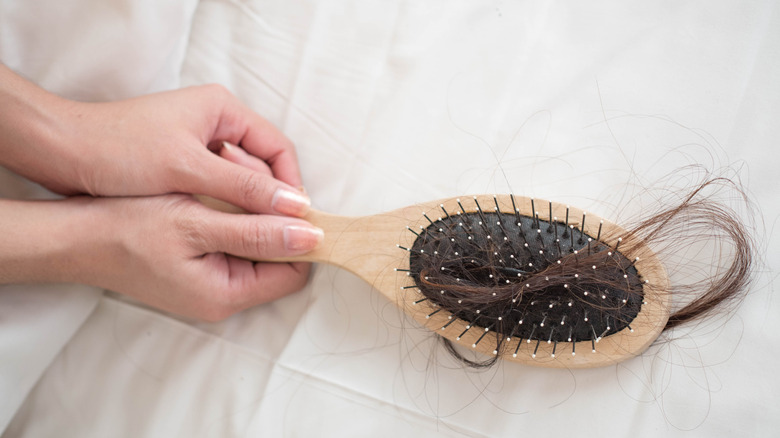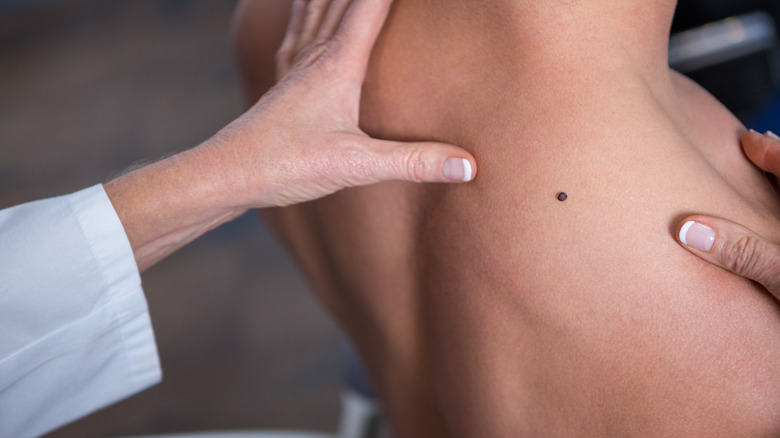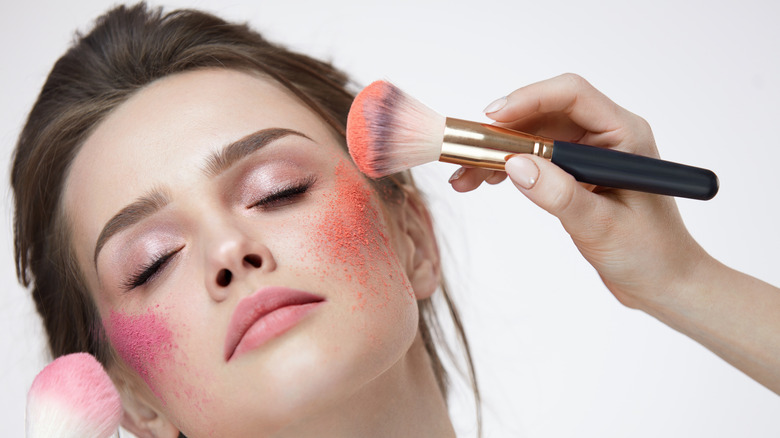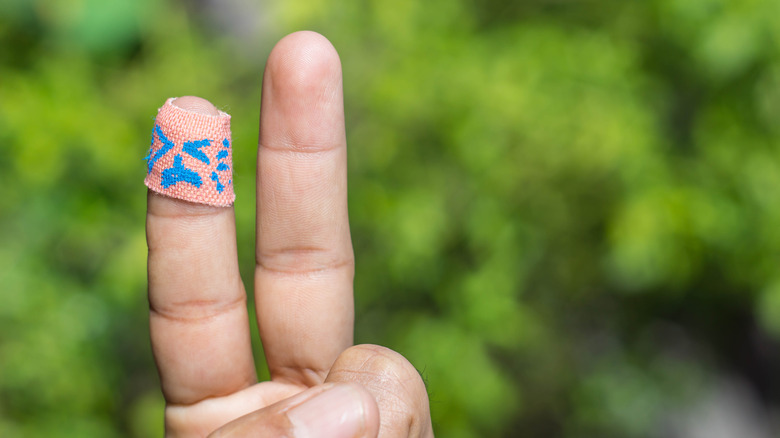Signs You Should Make An Appointment With Your Dermatologist
It's summertime, so that means beach days, barbecues with friends, and overdue appointments with the dermatologist. Long days in the sunshine feel amazing, but they also make it necessary for us to be safe. It's crucial to regularly see your dermatologist both for sun damage and a huge variety of skin ailments.
"It's a broad subject to talk about," Stan Kovak, MD of Kovak Dermatology & Laser Institute told me. "A dermatologist sees everything about the skin, from hair to nails. Signs and symptoms can be for just about anything." If you have been experiencing any of the following changes, make sure to make an appointment with your physician.
Itchy, red scalp
An itchy scalp is more than just annoying. Sure, your coworkers may be giving you sideways glances and scooting their chairs away, but it goes beyond that. You may have a chronic condition that can be treated.
Dermatologist Gary Marder recommended seeing your dermatologist if you've been noticing an "itchy scalp with raised, reddish, scaly patches." Don't assume that this is something you just have to live with. "This can affect your entire scalp and is generally a condition called scalp psoriasis," he told me.
Hair loss
Another scalp annoyance that you don't have to just take is hair loss. "If you notice the sudden appearance of a bald patch or experience excessive hair loss, your dermatologist could help," Dermatologist Allison Arthur told me.
There are quite a few reasons why you could be experiencing hair loss, and it takes an expert to determine what is causing yours. "This could be hereditary hair loss, alopecia, or caused by another medical condition or a medical treatment or medication," Dr. Marder told me. "A dermatologist will determine that for you."
Rather than trying the treat the hair loss yourself with over-the-counter products or by parting your hair on the other side, make the appointment and get to the root of the problem.
Bad sunburn
If you have experienced a bad sunburn this summer, that is enough of a reason to see the dermatologist. Sunburn is a sign of skin damage, so getting it checked out right away could save you a lot of time and pain in the future. If you notice any changes to your skin after time in the sun, make an appointment.
"A tender, wart-like lump that develops in a sun exposed area over just a couple weeks could signify a type of squamous cell carcinoma," Dermatologist George Skandamis told me. Instead of spending the rest of the summer worrying about that spot, ask your physician for next steps.
New skin growth
Part of the reason why dermatologists recommend checking your own skin regularly is so that you are able to recognize changes quickly. If you notice a new growth or mark on your skin, it's best to get it checked out right away. "See your dermatologist if you notice a new growth that doesn't go away within two to three weeks," Dermatologist Fayne Frey told me.
The new mark may be benign, but you just can't be sure on your own. "Any new or changing dark spot on the skin should be evaluated by a dermatologist," Director of Cosmetic and Clinical Research Department of Dermatology at The Mount Sinai Hospital Joshua Zeichner, MD told me. "Melanoma is a deadly form of skin cancer. Early detection and removal can be a cure. If you see something, don't wait, and make sure to get yourself checked out."
Worsening acne
Many of us think of acne as an annoyance that we just have to live with, but dermatologists disagree. Having severe or worsening acne isn't just embarrassing or uncomfortable. It can actually leave permanent marks and scarring, so don't let it get out of hand. "If you notice worsening acne, see a dermatologist to help prevent scarring," said Dr. Frey.
Changing mole
Any time you notice a mole that is changing, that is a big red flag that it's time to see your dermatologist. This could be an early sign of skin cancer, and the faster you catch it, the better. "If you notice a skin spot that is enlarging, changing color, itching, or bleeding, see your dermatologist," Dr. Arthur told me.
When it comes to changing moles, dermatologists always recommend watching out for ABCDE. "A" stands for asymmetry. Look for a mole that is abnormally shaped, rather than a circle. "B" is for borders. If a mole's border is changing, get it checked out. "C" is for color, so check to see if any of your moles have changed colors or are multi-colored. "D" stands for diameter. Any mole larger than six millimeters needs to be seen by a dermatologist. Finally, "E" stands for evolving. Any mole that is changing, especially one that starts bleeding, itching, or crusting over is concerning.
Another way to remember this warning sign is to check for any new spots. "Look for an 'ugly duckling sign,"" Dermatologist Jennifer T. Haley told me. "It is a new or changing spot that looks different from anything else on your body."
Change in nail growth
In addition to skin concerns, dermatologists are experts at treating your hair, scalp, and nails. If you have noticed a change in the strength or color of your nails, your dermatologist may be able to help.
"A dermatologist also treats nails," explained Dr. Kovak. "Look for discoloration, a raised-off nail bed, pus under the nail, or pain." If you have a nail infection brewing, your dermatologist can quickly treat it before it spreads.
Skin aging
Hallelujah! Skin aging is not something we just have to accept. Sure, there is a natural aging that we all experience, but your dermatologist can help keep you looking your best.
Dermatologist and Co-founder of DermWarehouse Alan Parks recommends talking with your dermatologist about healthy aging. "If you are noticing a lot of wrinkles or having problems with premature aging, talk with your doctor," he told me.
It is also important to talk with your physician before investing in expensive skin cream and treatments. There are a lot of options out there for skin aging, and you want to make sure you're buying the best products for your skin. "Before you purchase expensive skincare products promising you the world, like the fountain of youth in a jar, see a dermatologist," recommended Dr. Frey. He or she could save you a lot of time and money.
Permanent blushing
If you tend to always have red cheeks, start paying closer attention to your skin. The skin condition rosacea manifests as permanent blushing and can be treated.
"Oftentimes red, flushed skin, broken blood vessels, inflammation, and red bumps that look like acne are the result of rosacea," Dermatologist Joel Schlessinger told Self. "While the exact cause of this skin disorder is unknown, there are many factors that worsen symptoms such as sun exposure, wind, cold weather, hot beverages, alcohol, spicy foods, stress, and even exercise." So basically everything you enjoy and find fun is adding that red hue to your poor cheeks. Talk with your dermatologist about your treatment options.
Your dermatologist may recommend intense pulsed light (IPL) treatments. "IPL treatments gently deliver precise amounts of intense pulsed light through the skin's surface to treat rosacea on the face, neck, and chest," said Dr. Schlessinger.
New rash
A new rash can be very tricky to figure out on your own. If you Google pictures of rashes, you will be bombarded with images of every possible option, and they will probably all look the same to you. Do yourself a favor and go right to the expert. "Any kind of rash that covers a large surface area of the body should be evaluated and treated by a dermatologist," said Dr. Skandamis.
Your rash especially needs to be evaluated if it doesn't go away after a couple days. "If you develop a rash that does not go away within a few days, or that is accompanied by pain or fever, it's time to see your dermatologist," recommended Dr. Frey.
Sometimes chronic skin conditions like eczema can appear as a rash. It's important to see your dermatologist to get diagnosed. "See a dermatologist if you have acne, eczema, cysts, signs of aging like brown spots, signs of skin cancer, rosacea, fingernail or toenail infection, vein issues, poison ivy, a bad sunburn, and more," Dr. Marder told me. "A dermatologist is trained not only with skin but with hair, nails, lining of the mouth, and more."
A sore that isn't healing
If you have noticed a small sore that just isn't going away, start paying attention to exactly how long you've had it. Unfortunately this could be a sign of skin cancer, so it's crucial to address it. "It is important to see a dermatologist if you notice a sore on the skin that won't heal," Dr. Skandamis told me. "I often see patients with skin cancer that say they thought it was just a pimple, but it would not go away."
If your sore has been around for more than a few weeks, make an appointment. "Make sure to see your dermatologist If you have a skin sore that has been present for over a month and hasn't healed," Dr. Arthur told me.
Some bug bites can last up to a month, so don't worry right away. However, don't wait if it's gone past the 30 day mark. "Bug bites and pimples generally resolve within a month, whereas more serious conditions will not," Dermatologist Janet H. Prystowsky told Women's Health. "A skin condition that persists or is worsening and cannot be easily explained could indicate a skin disease and require treatment."
Excessive sweating
Here's some good news. Your excessive sweating could actually be treated. Dermatologists use botox and other treatments to address your overactive armpits, so why wait to get that taken care of?
Dr. Alex Roher is an anesthesiologist who specializes in dermatologic procedures and recommended seeing your dermatologist if you notice excessive sweating. "I also see patients dealing with excessive sweat," Dr. Roher told me. "If you are sweating a lot more than normal lately, or your skin has become extremely dry, you might have a hormonal imbalance."
If it has been over a year since your last appointment
Finally, if it has been over a year since your last dermatology appointment, it's time to get on the phone and schedule that baby. A lot can happen to your skin in a year, and let's be honest, there are a lot of nooks and crannies that you just can't check by yourself. As we age, we need to stay on top of this, but even young people are at risk for serious skin disorders.
"Make sure to go in annually for a full skin check," said Dr. Haley. "Melanoma is the most common cancer in 20 to 30 year-olds and board certified dermatologists are experts at detecting these cancers early. These annual visits are also a great time to discuss preventative strategies and personalized skin care recommendations."
Dr. Skandamis agreed. "Everyone should see a dermatologist at least yearly for an annual skin examination," he told me. A yearly appointment is also a great time to bring up any questions or changes you've been wondering about. The truth is, whenever we search the internet for medical answers, it is usually wrong. Dr. Marder reminded me, "never self diagnose!"


